|
|
|
 |
recorded some of Coot
Nelson's stories.
You'll enjoy them! |
|
 |
I've survived two plane crashes
in the service, being shot at by the Japanese in World War II,
two car crashes where the cars were totaled and one dog attack
while retrieving my mail outside my house at Crested Butte. |
I’ve been lucky all my life! |
|
|
My
father and mother
I did not know my father;
I was 3 months along the way when he passed away.
My mother had 1 girl and 2 boys and me on the way when he
died during the flu pandemic during WWI.
I learned after I moved to Watonga from Dr. Leisure that
this particular flu only hit the middle age group and the
healthy ones. It didn’t do any harm to the older
people and babies like you usually think of as being
vulnerable to illness |
 |
I was named
after my father.
But I didn’t find out until the 50’s that when my father was
born in Farmersville, Texas,
my grandparents lived beside a family whose last name was
Coot.
I guess they were very close neighbors.
I used to be Coot, now I’m the old Coot.
|
| I was two years old when my mother remarried. She married Joe Ab Clinton Moore. She
already had 4 children, and Joe had 5 children and then they had 6 children of their own.
You might think we had a large house; but it wasn’t that big! We managed. There was no fuss.
As far as I know none of us spent anytime in jail.
All the kids turned out fairly decent. It wasn’t just a matter of the older kids working; everybody worked. I don’t remember not being in the field.
Four of my
mother's sons did combat service
during World War II. |
I worked for 75 cents a day cultivating the fields. And I worked on the thrashing machine when I furnished 2 horses
and the machine and myself for $2.25 a day.
We moved to
Blaine County from Marshall County when I was about 7 years
old after my step-dad's brother came up to Geary from Marshall County
and found that they had good crops here; we had crop failures down there.
Mildred Sanders' grandfather Herb Shumate helped us move in
his pickup because we didn't have a vehicle. |
Back then, no community was without a baseball team. Where we lived, there were 3 baseball teams and there were a lot more teams that were in town.
Of course, a large family lived on every 80 acres. The teams were mostly made up of high school age kids; but there were some married guys, maybe 30 or 35 years old. They seemed old then to us!
|
| My junior year
at Geary I went out for football. Because of practice I would have to walk the 9 miles home to do chores every afternoon. Sometimes, I would catch a ride. I didn’t own a car until I got married. My older brother, Boyd, got a job so he could stay in town. My senior year, I got a job washing dishes at the restaurant so I stayed
in town and used the restaurant owner's 8x10 washhouse as my
living quarters.
Back then you didn’t worry about your kids being out alone. Bob Reid, who lived farther southwest of town than us worked in the filing station and Doyle Burns who lived 11 miles out of town worked in the grocery store. We didn’t have horses to ride, because the horses were work horse. Besides that, you would have to feed them and find a place to keep them.
I worked for R.A. Young at his store in Geary one Christmas time. Mr. Young had stores in Kingfisher and Nash. Mr. Tomlinson had a store in Altus and Mr. Goslin had a store in Cordell. They went together and started the T.G. &Y. stores.
|
click to
enlarge
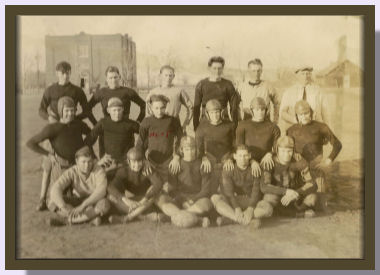
picture of a Watonga High School football team with the old
high school building in the background |
When I was a kid the best job in town was working at the ice plant. If you had a job working for the farmers, it only lasted through harvest. And farmers would want to pay you in chickens instead of cash money. There was just one electric box in Geary.
Sometimes you had to chip the ice to make it fit in the box and the pan underneath the refrigerator would collect water. So we were supposed to dump the pan and we were to chip the ice very carefully, just enough to make it fit, but not too much so that the customer didn’t get their money’s worth.
Boyd and I ran the town route and people would just put
their cards up in the window showing how many pounds of ice
that they wanted. We wore a cap that looked like a truck
drivers cap, and we wore uniforms; he was just a few pounds
heavier than me.
Sometimes
people would get after us if they didn't think that we
had done everything right. One time an upset customer
came looking for me to
correct me on some issue. When he approached me, I
just told him
that I was Boyd. I missed the bullet on that!
Bill Moore lived in an apartment over a garage. He had bought a coolerator with the deal that he receives free ice for a year so he wanted the ice to stay full. We would walk up two stories of stairs with a hundred pounds of ice on our shoulder
and walk clear to the north end of the house where the kitchen was while we chipped at the ice.
I worked ten hours a day, 7
days a week at 25 cents an hour. I also had the
privilege of working after hours on Saturday or Pioneer Day
with no extra pay. But there was no other job that was that
good of money. At the end of every week, I got $17.50 in cash
with no withholdings. I saved enough money to help me through
college.
|
I met Bette at Southwestern College through my older brother Boyd’s friends. Boyd and Harvey Base from Geary, were both wrestlers and they roomed together at OSU. Their future wives, Ima Jean
Bringham who was from Greenfield, and Nina Barns who was
from Geary, roomed together at Southwestern.
 |
Bette’s older sister
was married and lived in a house with an apartment upstairs
that she rented to the girls. So I got acquainted with Bette
through them. We dated several times at college and then when I went overseas we wrote letters. We weren’t very serious. When I got home from the service on Christmas Day, 1943, I drove my parent’s old truck over to Bette’s house where she was preparing to catch a ride back to the city. She worked at Douglas which is now Tinker. She didn’t catch her ride that night. Instead we talked about marriage. I said, “When?” She said, “Next Saturday night!” We were married on January 1, 1944. Everybody was shocked just as we were shocked.
They said it wouldn’t last! But we were temporarily married for almost 62 years!
I really thought I would be in the service for ever; but when we had to move every 3 or 4 weeks, we decided that that was not the life for us. We had some good friends when we were stationed up at Mojave. The girl was an only child and her father was an optometrist. We only got leave every 2 weeks, so one weekend we all went down to her fathers for the weekend. Her husband had already decided to go into medicine; but the father tried all weekend to talk him into optometry. Dr. Mann had just built a new office. All his talking did no good for his son-in-law; but he talked to him so much that it convinced me that I should go into optometry. I attended the Southern California School of Optometry for two years straight. We had class 5 and ½ days a week with no breaks. They had not had any graduates in so long because of the war; everyone was anxious to get into the work force. I was getting $65 a month from the military. That increased to $75 a month after six months. I got a degree, took the exam for the state board and came back to Watonga. We tried to have children when we were in the service because of the benefits. Within 6 months out of the service, Bette got pregnant; we had no insurance.
Timing is everything! |
|
click to enlarge
Officers VMSB-454
HELLDIVERS
Major J. H. Clark
Commanding
23 June, 1944 |
 |
I had no qualms about landing on a carrier. What they said to do, we did.
Being a country boy and all, the carrier looked awfully small, more like a postage stamp!
Coot is fifth man
from the
right on the front row. |
I had taken flight training at Southwestern College because I thought I was going to do that all my life, I was in the service 1 week and 1 day
when Pearl Harbor was bombed and my question was, “Where is Pearl Harbor?” None of us knew back then. It was just a service place for ships;
but when we heard about the attack we were all anxious to get into action. I became a flying cadet on February 5th, 1942 and I was dive bombing Japanese shipping on February 6th, 1943. I did my advance training in flight school on the old bi-planes leftover from WWI because they needed
the up-to-date planes in the war.
I only got 26 hours flying time in the combat planes before going overseas. |
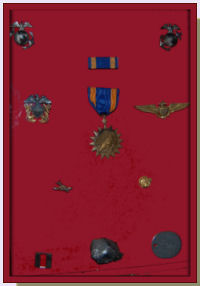 |
This picture shows
some of my medals and down in the middle
of the bottom of the picture is the Japanese shrapnel that hit the gas line during a bombing run in October, 1943.
It went half way in and stopped. It stuck there. I had to switch on the booster pump to keep us in the air. There were so many fumes that my gunner and I had to stick our heads out of the cockpit in order to breath.
I buzzed the runway
at the Marine's Air Base at Vella LaVella which was
busy landing 5 other planes. We landed quickly
and safely.
I
don't know how close I came
to getting them, but I know how close
they came to getting me! |
I was over there for a
year. The first 6 months,
I don't think I even
got a scratch.
But during the last
six
months, every time I went
out, I got hit!
|
|
| it reads: "Capt. Coot H.
Nelson, 24, of the U.S. Marines and Geary, has dived-bombed
his way into marital bliss. At Guadalcanal, the
dauntless dive bomber captain learned it's the man who acts
quickly who reaches his objective.
That explains why Bette
Dietrich is missing from the Douglas plant's blueprint
control department swing shift, only a few days after Nelson
hit town.
The dive-bomber saw Miss
Dietrich. His mind was made up. He squared off
for the approach, then leveled for the bomb run.
It ended with "do we, or
don't we? Is it yes or no?" He and Miss Dietrich will
be married Saturday at the home of her parents, Mr. and Mrs.
J.D. Dietrich in Rocky.
Miss Dietrich barely had time
to tell her friends at the plant goodbye. She will go
to the coast with Nelson to stay at least until he returns
to active duty.
A farewell trip to the plant
gave Nelson a chance to see how the Douglas planes are
built. "It looks mighty good to see those C-47s moving
down the lines," he said after a tour of the plant.
"Six months ago, it seemed to us down there we wouldn't be
getting any more planes."
Nelson's service has won him
a brace of medals, including a Presidential unit Citation
bar, as well as a star on the Asiatic Pacific campaign
ribbon.
He and his radio gunner also
bombed other Japanese installations in New Georgia, and only
last month Nelson was one of six Dauntless dive-bomber
pilots assigned to drop smoke to mark the landings at
Bougainville. Before entering the service three years
ago, Nelson was a football player and wrestler on the Geary
high school and the Southwestern Technological school's
teams. His mother is Mrs. Joe Moore, Geary."
|
Picture and article in the
Daily Oklahoman on Saturday, January 1, 1944.
 |
I've been asked to speak to
kids at various programs.
I don't necessarily encourage them to join the service;
but I always encourage them to get an education.
They say that 'luck beats skill';
But if you have an education, than that increases your
luck.
|
click to enlarge
 |
In 1945 my first carrier landing ended up being a crash landing. The carrier that I was on was a jeep carrier. I was in the first set of planes that went out. I was the first one to come in; the signaler brought me in too high
(we called him Hollywood Johnson because he went through so many motions). The tailhook
of the plane missed all the cables and went through
the barrier, then it set me up on my nose. This all
happened one evening; the next day, we broke the Navy’s record
by making 602 carrier take-offs and landings. |
click to enlarge
 |
|
 |
Bette and I had
twins on both sides of our family.
My older brother
Carl has twin grandchildren (1 boy and 1 girl).
The boy has twin daughters and the girl has twin
boys.
What are
the odds
of that! |
|
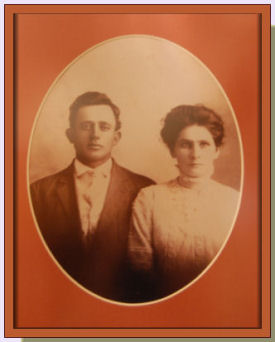 |
Bette's
parents
John and Ethel
Dietrich |
|
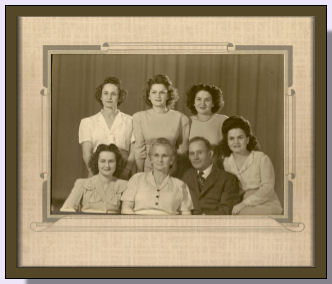
Bette's dad had 2 daughters
before he married Bette's
mother, then they had five girls together. |
We moved to Watonga in 1947. I opened my optometrist’s office
in rented office space from Arnold Goerke. Next door to me to the north was R.H. Morgan, the attorney and next door to that was the DHS office where maybe three people worked. Simms Service station was to the south of my office.
In 1960 I built the office where Tim is now. Three years after Tim began to practice with me I retired and turned it over to him. I remember that my first patient was a Mr. Anderson and I remember that things were slow; but we existed. We existed before we started making any headway. I was here 3 years before we got a new automobile, a ‘41 Ford. That was the second car I ever owned.
I do remember an Indian lady
in my early years of practice who could speak no English.
Her daughter was with her to interpret. When I walked
into the examining room where she waited for me, she was
busy taking her blouse off. Her daughter and I began
wildly waving our arms and saying, "No, No! This is
the eye doctor!" In ‘52, twenty-nine families went together to form an organization to build Circle Drive. A 3-bedroom cost $9,500 and a two-bedroom cost $7,200. Our payments including insurance and taxes were $63 a month. We lived there until ‘59 when we built this house in the country.
The Clewells lived across the street from us. Their son, Paul, and our twins were about the same age so they played together quite a bit. One day, Paul came running into our house crying. He told Bette that Rick hit him over the head with a sand bucket. So she went straight outside and
whacked Rick’s bottom. Then Paul said,
“Why did you hit him?
He was the one that done it!” And then he pointed at Tim.
|
|
click to enlarge
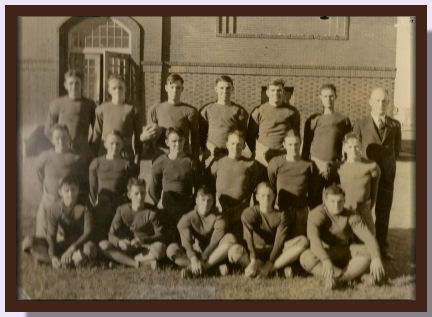 |
Watonga High
School Football Team (early forties, maybe)
Top row:
Kenneth Christian,
Phil Brown, 'Red' McClure,
Lois Clinger, Hugh Compton, Delbert Scott, L.P.
Rice (Coach)
Center row:
'Red' Kemp,
Mike Pearson,
Ellsworth Chaufty, 'Hi' Neal, Keith Boyd, Beryl
Cruse
Bottom row:
'Catfish' Sims, Basil Crawford, Kenneth Morton,
Fred Hill, (Little Red) McClure |
|
When I moved to Watonga, the main street was paved to the west just to where First State Bank is and to the east, just short of the railroad tracks. The streets were paved to the north of Main Street for a block and to the south of Main Street for a block. The rest of the roads were gravel or dirt.
The high school team played football at the fairgrounds. And on a game night, these kids would drive all over town after the game stirring up the dirt. You couldn’t get to sleep until after midnight when the dust started to settle because everybody slept with their windows open because of no air conditioning.
Our football team won state in 1948. Dean Wilde was the coach then. I remember helping take money at the gate. There was about half a dozen of us that would work different gates. The price of admission was 75 cents. We finally talked them into letting us charge $1 so we wouldn’t have to mess with so much change; the people didn’t like that too much!
On Saturday night, a lot of people would come downtown just to see who was in town. Most people would stay in town until after the preview let out, about 12:30 am. The barbershops even stayed open. Men would sit in there and talk for two hours and then decide to get a haircut. All three of the drug stores would stay open.
|
I was a member
of the Watonga Kiwanis for 37 years with perfect attendance. |
click to enlarge

We are all either
holding a hat or wearing a hat. We're posed in
front of the
old VFW Hall that used to be across the street west
of First State Bank. |
Front Row:
Arnold Goerke, Cotton Gin
Bert Hippard, City Treasurer
L.J. Barrett, Banker
Sam Swanson, Manager, Long Bell Lumber
Middle Row: Coot Nelson,
Optometrist,
Tom Chapman, Chevrolet Dealer
Emett Wray, Insurance, Jack Barrett,
Banker
"Cowboy" Curtin, Newspaper
Back Row:
M.L. McFarlin, Chamber of Commerce
"Smoke" Knappenberger, Postmaster
G.E. Gaines, County Superintendent
B.B. Haralson, Insurance, unknown,
E. Blumhagen, Attorney, Max Shaw,
Davidson/Case
unknown, unknown, Vic Loewen,
Implement Dealer
Russell Strayhorn, O.G.&E., "Chick"
Jamerson, Hatchery,
George Gott, Consolidated Gas Manager
Fred Hindman, U.S. Soil Conservation,
Max Barrett, Dentist, Clyde Robinson,
Attorney, unknown |
| The highway that goes north of town toward Roman Nose used to be on Laing Street. You used to go by the high school to drive out to Roman Nose.
I haven’t directly accused Hod Tolbert of moving the state highway over to the street that he lives on; but he was in the State Senate at the time.
They didn’t pave the
roads around Roman Nose until the ‘50s. It was nice
to go to the park, but you had to pick your good
weather. If you got caught out in the rain, those
hills were slick.
They used to get the water for the swimming pool at Roman Nose from the stream that goes by the pool. Then they decided somebody might catch something from the creek water, so they quit that.
|
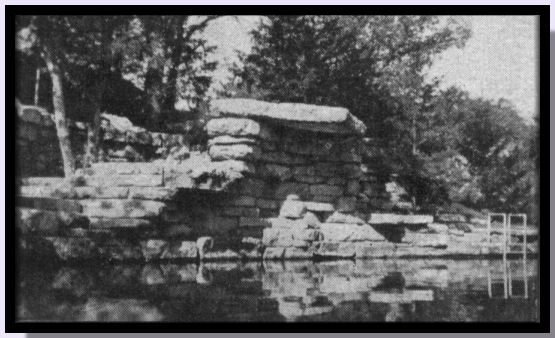
That stream water was
cold as ice even in the middle of summer.
|
|
|
|
Bette and I
sponsored Ronnie Kaye's Teen Hops for about ten
years in Watonga at the City Hall Auditorium.
Bette would sit outside and take the money; she
didn't like all the noise. We didn't allow
beer in the building and if I had any trouble out of
the kids, I just called on the aid of one of the big
football players that would come over from
Southwestern.
In 1969, my son Dietrich and Ronnie Kaye's
sister-in-law partnered to win a dance contest on
the Dick Clark Band Stand and they each won an
automobile.
One Baptist preacher
gave us a hard time for promoting dancing among the
teenagers; but if we had not had the Baptists, we
wouldn't have had a crowd! |
 |
|
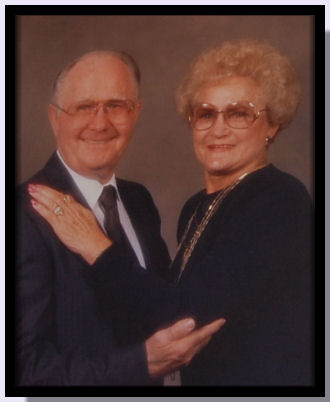 |
We spent quite a bit of time with Betty and Leland Jones. He was a character; he worked as a rural carrier. Once we packed the station wagon and struck out for Wisconsin. Bette had heard of a house on the rocks that cost $10 to go through it; but it was something to see! We went on north up to Canada, then across to Queensland, and back down into Maine, then back up into the island, Prince Edward, then back down to New York. We were gone four weeks and we were still speaking to each other when we got home.
We used to belong to a dinner club with the Jack Barretts, the Clemon Clewells, the Joneses, the
Knisleys, the Wolseys, Pierce and Wilma Shackle, the Houses, Hubert and
Tincey and the Clyde Cranes. We took a train ride through Copper Canyon which is just inside the Mexican border.
About 4 o’clock in the afternoon,
four Mexican soldiers got on the train. They
were dressed fit to kill in their military uniforms
with their Tommy guns over their shoulders.
Even the Mexican people on the train kind of eyed them when they walked by.
Our group was scattered throughout the train so I
was able to talk to the soldiers without the group
hearing me. I had to do a lot of talking, but
I finally convinced one of the soldiers to go back a
couple of cars to where Clyde was sitting and motion
him to come to the front. He didn't know what
to think, until he saw me sitting with the other
soldiers. We all laughed about
it later and Clyde claimed he would get even with me.
I first thought I’d get Jerry, but I was too afraid
of his temper! |
Here next month I’ll turn 90; it is not time to go yet! Boyd is still living;
he is three years older. I have another brother, Carl, still
living who is five years older than me. I’ve
still got to get even with them on a few things. It will be a challenge! |
|
click to enlarge

1916 - Anybody know who these
five guys might be??
if you'd like to comment on
this interview, send comments to
this email
Really enjoyed the article. My grandmother and family (Chaufty) were from Watonga and a lot of them are buried there. It’s fun to see a bit of Watonga history through Coots eyes.
--Marcia Skiver
When visiting with Coot
in Crested Butte recently he mentioned this website
and article. I have known him and Bette for 30yrs.
Bette used to briefly talk about their "history",
but Coot has always been very closed mouth about his
life, especially the flying days. What a joy to be
able to read about his exploits and the family
history. Thank you so much for such a delightful
article. Mary Jursinovic Paonia, Colorado
Mary Jursinovic
http://www.crestedbuttepottery.com
Nita, thank you so much
for the articles about Watonga's people. It was
wonderful to read about Dad. I heard these stories
as a child when we lived in Circle Drive. At night,
we'd take a blanket & put it on the front yard and
Mom would have Dad tell us stories of growing up,
WWII, etc. I now look back and realize that those
were precious time of learning about family
history. My dad has always been my friend and my
hero. He has a wonderful sense of humor, vitality,
and character. Actually, not only does he have
character, but he is a character! He has always
been there for all of us. I've remarried and my
husband Tim adores my dad as well as the rest of the
family.
Thank you again for everything.
Lou-Ann
Nelson Timmons
This was a great article. I
remember growing up hearing all these great stories
about Granddad going to war and how he and Granny met. I
think all the grandkids loved hearing about it, even the
great grandkids... All ten of us!! You can't help but be
proud that he's our Granddad, our Old Coot!
Alyse Threadgill-Trumbley
Anita,
I especially enjoyed Coot's article, and am enjoying the
remarks made by friends and family members...
So many of my own memories begin to join with the
memories of others and it just connects us to one
another.... This has been such a neat addition to your
page.
I enjoyed his stories and the way he told them...but I
also enjoyed the old 1951 telephone directory.... I
found some neat telephone numbers in it.
Chapman Chevrolet phone number was 66....
I vividly remember the simplicity of just a few numbers
compared to the area code-prefix-number that we have
today... I remember when we could just call the operator
and ask for the
phone number of someone, and she would give you the
number and ring it for us... I guess you say, "That was
in the old days"...They were neat...but,
I don't want to go back....
Betty Chapman
Anita, you do such excellent work on
the Watonga page.
You are to be commended on it for I
know it must take a great deal of your time to do this.
Now regarding the Nelson story ; I
read their story placed in Watonga's Centennial Book and
I knew some of the basic facts in it but because this
story gave us more family background and more local
history I was spellbound. I even found an uncle in one
of the pictures.
I particularly enjoyed his flying
adventures in WW11 and then starting his long practice
in Watonga.
He, like Clemon and Betty, brought
back good earlier day memories.
After reading Betty's story I felt
compelled to say, ' Isn't she a Hoot ?
', so now I must say ' He really is a
Coot ! '.
Phyllis Humphrey
|
|